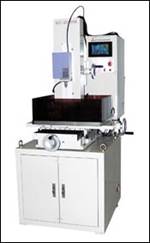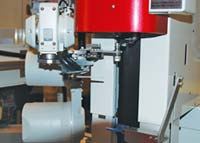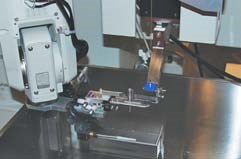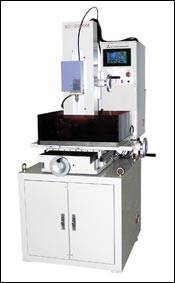Incorporating Automation into Your EDM Drilling Operation
Every shop that uses EDM drilling technology is a prime candidate for automation. Some just don’t know it yet.
Automation for EDM drills comes in two main forms: (1) simple mechanical toolchangers and (2) comprehensive robotic systems. Both perform essentially the same function. However, where a toolchanger usually just moves the tool chuck in and out of the machining head (albeit automatically), a robot can also transport electrodes, guides and workpieces in and out of the machine—whatever you can program it to do.
It is a simple process of telling a CNC or a PC control what you want to accomplish. But even in 2008, some shops still shy away from automation—some for fear of the technology itself, others out of a concern that if the robot serving two or three machines goes down, the whole operation stops cold.
When it comes to EDM drilling automation some mold and production shops often say, “What are we going to do with this? We really don’t have an application for this.” But if they invest in automation they could see a 100 percent increase in productivity, an increase in applications for outside work and shortening up of some of their work.
Fear Not Beneficial Technology
Among shops that suffer from techno-phobia, many jump into EDM work believing, “I just have to have the machine, and my guys can change these electrodes in and out.” This mindset usually results in a lot of downtime for machines. People can get distracted or called away on another job, and before they know it, a machine can sit idle for hours.
This kind of downtime is a killer for any shop, but especially for shops trying to keep up with today’s just-in-time customer demands. The good news is that this downtime is completely avoidable. You do not need a process engineer or engineering firm to automate your operation for you. All it takes is an EDM or robotics vendor to work with you to customize it to your EDM drilling operation.
Toolchanger
A simple toolchanger that adds only about $20,000 to the cost of an EDM drill can keep an EDM drill running until all the electrodes in the carousel have been used up. We’re not talking about huge amounts of space here; we’re talking about brass pipes that are perhaps 150 mm to 400 mm long and 1mm in diameter.
Robots
Robots are more costly, but accomplish much more in return. While carousels typically hold anywhere from eight to 20 chucks—depending on the vendor—robots can handle 50 tool chucks or more. It all depends on how you have the toolholding rack designed. The robot doesn’t care, as long as it can reach the tool.
Robots also can change out guides. This type of automation is more advanced than most shops require; however, it is particularly useful if a part requires two or more differently sized electrodes because each new size requires a new guide that matches its own diameter.
People
In addition, and more important, relying on the toolchanger to do what you otherwise would need operators to do frees up those valuable operators to do the higher-level tasks that truly add value to your operation. The concern here is not so much time as it is making the best use of your people.
For example, it usually takes an automatic toolchanger 90 to 120 seconds to replace a small drill chuck. An operator might do it in 40 seconds. It’s like a toolchanger on any other machine. The operator can always change it faster, but he has to be there (and he probably will not be there in the middle of the night).
The issue is not change-out time—operators can actually do it faster. The issue is not accuracy, either. While automation reduces human error in change-outs, it does not improve machine accuracy at all. The issue is people, and your people should have more productive things to do than standing around—such as helping to plan the next job for their machines.
In fact, the most successful mold shops are the ones that plan the best, especially in the current environment of just-in-time machining. To keep up, shops must spend an enormous amount of time planning jobs. They have to hit their numbers just right—how long a piece is going to be in the grinder, then the mill, then the wire EDM, then the sinker EDM.
There is precious little room for error, so planning is key. However, planning is generally done at a desk, away from the action on the floor. So the only way to keep that EDM drilling machine running consistently is to automate.
A word of advice: As much as the operators at the bench hate to admit it, that guy who sits at the desk and actually designs the molds and dies has the best view of the whole job. The people on the floor know a lot, but not all the little details. The designers see the overall picture, and the most successful shops allow the designers to run the production through the shop. The more the designers and operators communicate in the planning process, the more efficient the shop will be—and the better use it can make of automation.
Ancillary Equipment Recommendations
Shops looking to make the most of their automation also should consider employing a chiller unit on their machines to keep the system as stable as possible. They also should make sure that the system they use to deionize their water is reliable, and that the diameter of the electrodes they use is uniform. Otherwise, all of the time they gain by automation will be stolen by electrodes sticking in guides or an overheated machine.
Summary
Automation can be included in new machines and integrated into old ones for a fraction of the price of paying people to stand around and waste time. As just-in-time work, smaller batches and competitors’ use of automation becomes more commonplace, even the most technophobic shops would be wise to look into automation. Anyone can do it, and even the simplest automation solutions can help you immensely.
Related Content
What is Scientific Maintenance? Part 2
Part two of this three-part series explains specific data that toolrooms must collect, analyze and use to truly advance to a scientific maintenance culture where you can measure real data and drive decisions.
Read MoreHow to Use Scientific Maintenance for More Accurate Mold and Part Troubleshooting
Discover how adopting scientific maintenance approaches helps improve mold lifespan, minimize failures, and optimize production outcomes.
Read MoreAchieving Flexible Capacity with Automation
This high-mix, low-volume manufacturer embarked on a year and a half program to introduce robotics to its manufacturing process.
Read MoreAdvancing Moldmaking and Plastics: Trends in 3D Printing, Automation and Sustainability
NPE 2024 showcased the latest trends and technologies in innovation, efficiency and sustainability for moldmakers and molders, featuring advancements in 3D printing, automation, design and virtual reality/augmented reality/artificial intelligence.
Read MoreRead Next
How to Use Continuing Education to Remain Competitive in Moldmaking
Continued training helps moldmakers make tooling decisions and properly use the latest cutting tool to efficiently machine high-quality molds.
Read MoreReasons to Use Fiber Lasers for Mold Cleaning
Fiber lasers offer a simplicity, speed, control and portability, minimizing mold cleaning risks.
Read More























